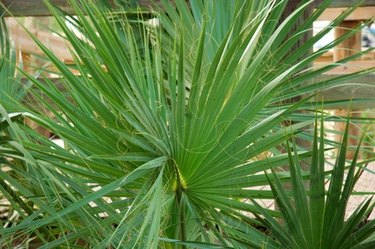
Wondering how to care for a cataractarum palm (Chamaedorea cataractarum)? These plants, also known as cataract palms, cat palms and cascade palms, are small perennials categorized as clustering palms. Cat palms make good indoor plants, and they can add a tropical feel to your home, though they can also grow outdoors as perennials in USDA plant hardiness zones 10 and 11.
Cat Palm Physical Appearance
Video of the Day
Cat palms do not have trunks. They also do not grow very high, topping off at about 3 feet if kept indoors and about 6 feet if kept outside. They have green, cane-like stems and dark green, glossy leaves. These leaves are pinnate, meaning that they grow on the sides of the stems, usually in pairs that are opposite to one another.
Video of the Day
These leaflets are thin and long. Cat palms are also prone to form large, dense clumps of leaves as they mature. They can grow out widely, and since they are easy to care for, they are popular houseplants.
Planting Cat Palms Outside
Look for a partially shaded location that does not get more than six hours of sunlight every day if you plan to put your cat palms outdoors. Plant the palm on rich, well-drained soil but add in top soil or organic peat moss to keep the roots moist. Water often (daily if necessary), and fertilize three times a year, in the spring, summer and fall, using a palm fertilizer according to label directions. If the palm is in a sunnier spot, you may have to fertilize more often.
Indoor Cat Palm Care
All houseplants should live in pots with drainage holes, otherwise, their roots will be too wet. Place your indoor cat palm in a sunny spot with a light potting soil mix that drains well; look for mixes with peat moss and perlite. Heavy mixes that have a lot of clay are not good for these plants. Watering times will depend on how dry the cat palm's soil is.
When temperatures are warm, your cat palm may only need to be watered every five to seven days. Cooler conditions require less water, so doing this once every other week may work. Keep the soil moist to ensure that the roots are well hydrated but cut back if there is standing water in the soil; add water if the top 2 inches are dry.
Fertilize your cataractarum palm every March, June and October with a palm tree fertilizer. Read the package instructions carefully before applying. Indoor and outdoor cat palms will also benefit from regular pruning to remove dead, diseased or discolored leaves.
More Cat Palm Tips
These plants like moisture, and they prefer 55 or more percent humidity when indoors. Cat palms sometimes suffer from mineral buildup, which can stunt their growth. To prevent this, flush out the soil by pouring water over it for two to three minutes and allow it to drain.
Cat palms also tend to get bushy, so you may want to trim yours back a little if it is taking over its area. Using a pair of sharp pruning shears, cut some of the fronds at their bases. Do not touch any other stems on the plant, though. You can also remove any brown leaves, which will keep your cat palm looking better.